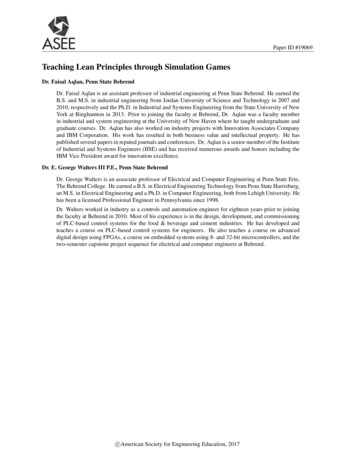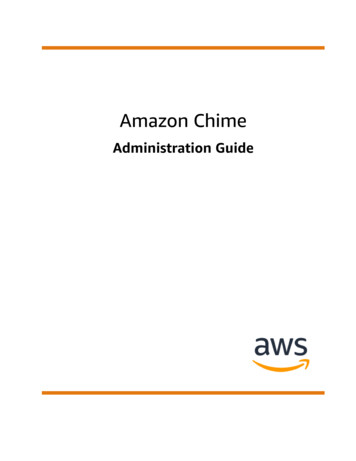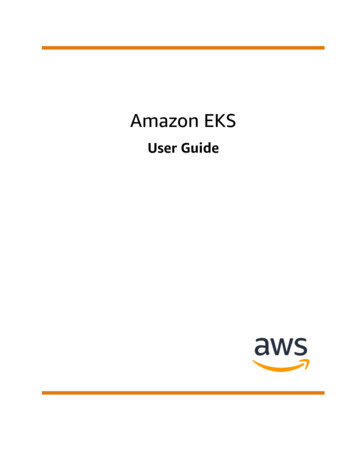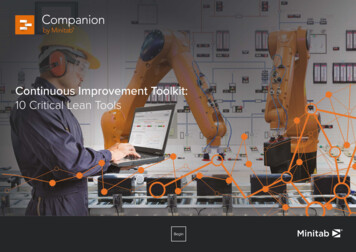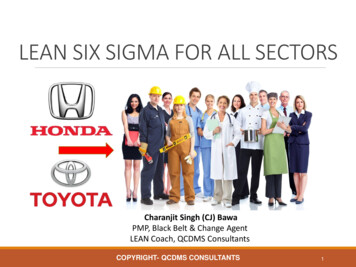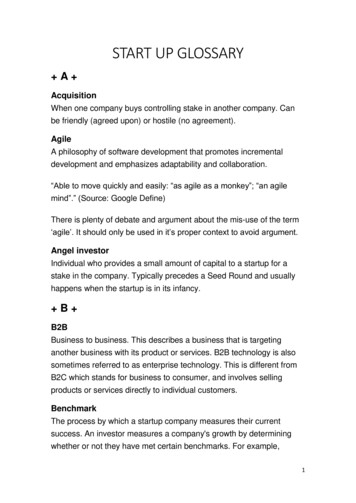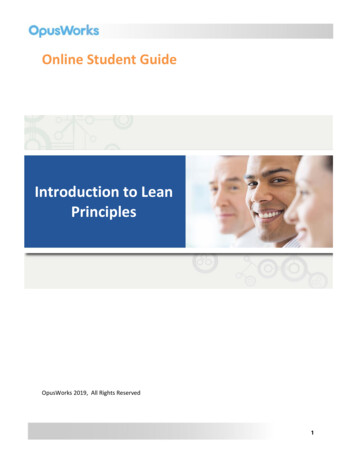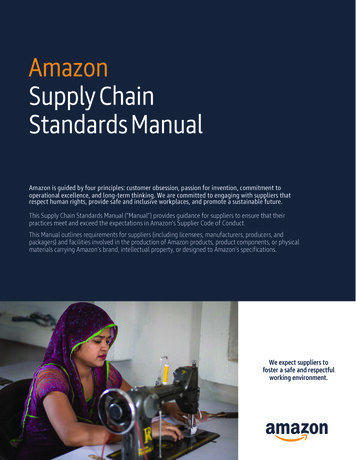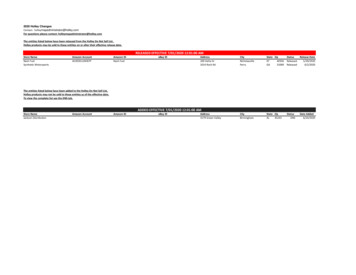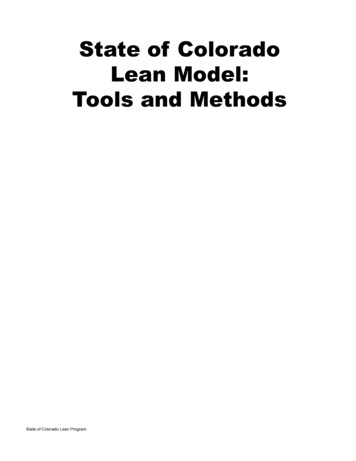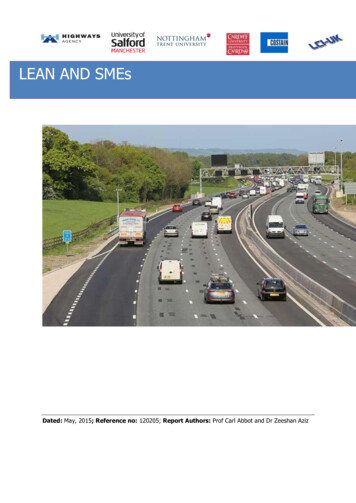
Transcription
LEAN AND SMEsDated: May, 2015; Reference no: 120205; Report Authors: Prof Carl Abbot and Dr Zeeshan Aziz
Printing copyrightUniversity of Salford,Salford, M5 4WT, England.All rights reserved; no part of this publication may be reproduced, stored in a retrieval system, ortransmitted in any form or by any means, electronic, mechanical, photopying, recording, or otherwisewithout prior written permission of the copyright owner. However, there is no restriction on the onwardcirculation of this report in electronic form provided it is transmitted in its entirety.School of Built Environment,University of Salford,Manchester,M5 4WTW: www.salford.ac.uk
ContentsIntroduction4Lean Implementation4Learning From Toyota4Lean Thinking5The Toyota Way6IMPLEMENTING LEAN IN CONSTRUCTION7Barriers to Lean8Resistance to ChangeResistance to LeanOvercoming Barriers8910Construction SMEs11Conclusion12References13
INTRODUCTIONThis report provides a literature review aimed at supporting the Highways Agency (HA)with Lean Implementation in the Small and Medium sized Enterprises (SMEs) withintheir supply chain. In doing so the report considers good practice in leanimplementation; the particular characteristics of construction SMEs; and case studiesand tools that are currently used in the construction industry. The report is intended toinform further primary research in the form of interviews and surveys in order toprovide recommendations to the HA for successful implementation of lean within theirsupply chain SMEsLEAN IMPLEMENTATIONLEARNING FROM TOYOTALean principles are founded on the practices of Toyota. Therefore, before consideringlean implementation in the context of the construction industry it is worthwhile lookingat the principles that have guided their implementation within Toyota itself. (Liker,2004) emphasizes the reliance on every worker’s active involvement in continuousimprovement that is at the heart of lean practice within Toyota:“THE MORE I HAVE STUDIED TPS AND THE TOYOTA WAY, THE MORE IUNDERSTAND THAT IT IS A SYSTEM DESIGNED TO PROVIDE THE TOOLS FOR PEOPLETO CONTINUALLY IMPROVE THEIR WORK. THE TOYOTA WAY MEANS MOREDEPENDENCE ON PEOPLE, NOT LESS. IT IS A CULTURE, EVEN MOREthan A SET OFEFFICIENCY AND IMPROVEMENTS TECHNIQUES.YOU DEPEND UPON THE WORKERSTO REDUCE INVENTORY, IDENTIFY HIDDEN PROBLEMS, AND FIX THEM. THEWORKERS HAVE A SENSE OF URGENCY, PURPOSE, AND TEAMWORK BECAUSE IFTHEY DON’T FIX IT THERE WILL BE AN INVENTORY OUTAGE. ON A DAILY BASIS,ENGINEERS, SKILLED WORKERS, QUALITY SPECIALISTS, VENDORS, TEAM LEADERS,AND – MOST IMPORTANTLY – OPERATORS ARE INVOLVED IN CONTINUOUSPROBLEM SOLVING AND IMPROVEMENT, WHICH OVER TIME TRAINS EVERYONE TOBECOME BETTER PROBLEM SOLVERS.”The above quote emphasizes the wholesale change in culture and practice that isnecessary before an organization can be thought of as lean. Any organization thatpractices lean will have undergone a considerable period of change in order to embedthat culture in its everyday practices. Therefore, it is essential to think deeply over notonly which lean tools are to be adopted by an organization, but also what are the mostappropriate steps to take in order to make the transformation successful? Given thatthe roots of lean thinking are embedded in Toyota it is worthwhile considering whichlessons can be learned from Toyota in terms of lean implementation.
LEAN THINKINGWithin ‘Lean Thinking’, Womack and Jones (1986) make specific recommendations forthe application of lean principles within an organization:1.2.3.4.5.6.7.Find a change agentGet the knowledgeFind a lever by seizing a crisis or creating oneForget grand strategy for the momentMap your value streamDemand immediate resultsAs soon as you have momentum expand your scope.The importance of a change agent to drive action is emphasized. “Action is a mustbecause it develops a new mind, and gives people confidence that changes can bemade. Above all the change agent must have the courage to cause principle drivenaction, and to stand against attempts to dilute lean.”Although the emphasis is on action this must be supported by knowledge. “Obtainenough knowledge to begin implementing lean and then continue to gain knowledgethrough implementation. Do not ignore the need to understand basic productionmanagement principles.”The idea of a crisis is used as a means of ensuring that everyone understands theimportance and the need to change. The key point here is that people must beconvinced of the need to change.Mapping the value stream is important in its own right, “The advantage is that it revealsgaps in performance and practice, and may deliver almost immediate improvement”,but also because it creates an increases in the visibility of waste, “Demonstrating anorganization’s waste in a process provides an irrefutable business case for the need tobe lean; making visible the scale, quantity and location of waste and the potential forspecific efficiency gains provides a powerful argument.”Although lean implementation should lead to tangible results these may not solely befinancial. “Reduced costs within an activity are the wrong results to ask for, just asmore rapid completion of tasks. Better to ask for immediate results in planningperformance and for demonstration of how such improvements translate into reducedbacklogs between activities.”It is important to expand the application of lean principles, however, the emphasis is onimproving project planning first and then expanding rather than the development of anew supporting system around inadequate projects. “ . it is believed that designing asupporting system to mesh with an inadequate project planning system is starting atthe wrong end.” If the preceding steps are in place the scope of lean implementationcan be expanded.
THE TOYOTA WAYIn the ‘Toyota Way’ Liker (2004) presented 13 “tips” to facilitate Lean implementation.These tips are listed below.1. Start with action on the technical system, follow quickly with cultural change2. Learn by doing first and training second.3. Start with value stream pilots to demonstrate Lean as a system and provide a“go see” model.4. Use value stream mapping to develop future state vision and help “learn to see”.5. Use kaizen workshops to teach and make rapid change.6. Organize around value streams.7. Make it mandatory.8. A crisis may prompt a Lean movement, but may not be necessary to turn acompany around.9. Be opportunistic in identifying opportunities for big financial impacts10. Realign metrics with a value stream perspective.11. Build on your company’s roots to develop your own way.12. Hire or develop Lean leaders and develop a succession system.13. Use experts for teaching and getting quick resultsThese principles are grouped by Liker (2004) according to four broader dimensions: a)Long term philosophy; b) Process improvement; c) People and partners development;and d) Continuous improvement. Liker (2004) also emphasize the importance ofkeeping the company’s identity during the implementation of Lean. Liker argues thatevery company is unique and should search for the most appropriate set of toolsaccording to the company’s context.There is much agreement between Liker and Womack & Jones. Both emphasiselearning by doing as the starting point. Both set out steps that need to be delicatelybrought together with care and attention and require a targeted approach. Likeridentifies that changing the culture and mind-set of all employees is crucial tosuccessfully implementing Lean. To do this the organisation must find someone whowill champion Lean ideas; this person has been called the ‘Change Agent’. This personmust have leadership qualities (as opposed to managerial qualities discussed by Lucyet.al. (2005)), with the courage to stand up against any attempts to dilute Lean.Lean requires decentralised decision making, which will be fiercely resisted by thosewho equate it to a loss in their power. And those that are at this time are disengagedemployees, they will need to be re-engaged if lean is to work. For success to occur thechange agent will need people at all levels of the organisation to be exemplifiers of leanprinciples and action, so that eventually all employees will be empowered with theprinciples of Lean.
IMPLEMENTING LEAN IN CONSTRUCTIONThe previous section considered generic principles for lean implementation based onthe practices within Toyota. This section of the report looks at lean implementation inthe specific context of the construction industry. It cannot be over emphasised(Lawson & Price, 2003) that the origin of Lean and therefore much of the literature andtheoretical scholarship is directed to manufacturing type processes undertaking thesame or similar types of tasks. Many companies and public institutions thought thatLean practices could easily be transposed to all types of organisations. However therehas been limited success implementing Lean in the British National Health Service(NHS) (Radnor & Osborne, 2013) and also in its take up in the construction industry.Koskela (2013; 2000) points out three peculiarities of construction; each project is oneof-a-kind, the production takes place on-site and it is through a temporaryorganisational structure. This has led to a discussion as the how adoptable Lean can bewhen applied outside the manufacturing environment and much good work has beencarried out by the International Group for Lean Construction (ICLC, 2014) over the lastdecade to develop a set of Lean principles and tools focused specifically for the projectbased construction industry.There are not many papers that deal with the specific of lean implementation inconstruction organisations. Arbulu and Zabelle, (2006) consider that:“the main challenges organizations are facing when trying to transformthemselves into a lean organization is a combination of two aspects: (1) lackof understanding that lean project delivery implies a different way of doingbusiness in construction, and (2) how this transformation is currentlyapproached.”This again indicates that companies need an understanding not only of lean principlesbut also steps towards implementation“Organizations can be understood as a combination of different elements such asvalues, culture, processes, structure, people and skills, and systems. Theimplementation of lean in construction is really a 'transformation' process from a currentstate (the way the organization operates now) to a future state where thecharacteristics of these elements are redefined to enable lean project delivery andincreased competitive advantage in the market.” (Arbulu and Zabelle, 2006, p.555)However, Arbulu and Zabelle introduce a note of caution about pushes to adopt leanconstruction, “This [specific demands from the market] is pushing organizations toadopt a 'shallow and wide' implementation approach typically conceived and mandatedby leadership, and then communicated from the 'top down' without proper stakeholderengagement.”This is counter to the Toyota approach as described by Womack and Jones, and Liker.Both of their books described an action first approach followed by a more widespread
uptake. Here there is a particular advantage for construction “The construction industryhas a key advantage compared with other industries regarding how to approach asustainable lean transformation. This advantage is 'projects' . Taking projects as thebasis for transformation enables a narrow-and-deep implementation approach.” (Arbuluand Zabelle, 2006, p.557)As per the previous section these critical changes then represent “the start of acontinuous process where old systems are disconnected, incentives are changed,processes are streamlined, and vision is reinforced through heavy-weight projectleadership.” (Arbulu and Zabelle, 2006, p.557)According to Arbulu and Zabelle the main benefits of adopting this ‘narrow and deep’approach include:1. Maintain current operations while transformation occurs. The objective is asmooth transformation.2. Better control of when the break point occurs. The break point is defined as themoment where at least 50% of projects are being delivered through the newbusiness model.3. Better control of capability development. The adoption of the new businessmodel imposes many technical challenges for leaders and project teammembers.4. Better decision making regarding which project is next in the transformationprocess. For example, companies may want to gain competitive advantage fasterby selecting projects from key clients or industry sectors based on theircontribution to the organization's revenue.5. The impact of top-down leadership support is higher thanks to working in a morecontrolled environment (e.g., one project instead of ten). A lean transformationinitiative requires significant time dedicated to lead teams through change.BARRIERS TO LEANThe preceding has set out a series of actions necessary for a company to successfullyimplement lean. The range of these actions illustrates the complexity of theseprocesses. For lean implementation to fully succeed it will require all of the stepsillustrated to be successful. It is therefore worthwhile considering the barriers thatinhibit the take up of lean.RESISTANCE TO CHANGEWhen a company implements Lean it will go through two processes, ‘change’ and‘transformation’. Bridges (2002) explains that ‘changes’ are situational; a new site, anew boss, a new role within a team, a new policy. This is the starting point of leanimplementation, the starting point of ‘action’. Whereas ‘transformation’ is thepsychological process people go through in order to come to terms with the newsituation. Lucy et al (2005) succinctly summarizes Kotter as follows; Kotter (1996)states that major transformations have helped organisations such as GE, Allied Signal
and Motorola adapt significantly to shifting conditions but, in too many situations, theimprovements have been disappointing and the carnage has been appalling, withwasted resources and burned out, scared or frustrated employees. Kotter goes on tostress that the downside of change is inevitable. Whenever a business is forced toadjust to shifting conditions, pain is ever present and a significant amount of waste andanguish is unavoidable. The key issue is knowing how to enact change and, ofcourse, it is important to have a clear vision and to get everyone in theorganisation supporting it. These three statements in bold, may look obvious, butthese are the most important hurdles to overcome for a successful implementation of aLean strategy. Lean must be seen as a long term goal that should grow within thecompany over time.The person or team that will implement a Lean strategy can be either be ‘Managers’ or‘Leaders’. Kotter (1999) explains that “Management is not leadership; it is more aboutcontrolling and problem solving and producing the short term results expected by thevarious stakeholders. Leadership is about establishing direction, developing a vision ofthe future and setting strategies for making the changes needed to achieve that vision .”Leadership is what is needed for a company to succeed generally and especially whenimplementing Lean, (see Liker’s 9th principle). The employees that are the ones who willbe implementing a Lean strategy must be fully engaged in the process right from thebeginning. Understanding how to motivate, encourage, and support employees isparamount for the success of any company especially one that wants to implant a Leanstrategy. Lean by its very nature implies reducing waste and redundancy in theworkplace. Employees may feel that they are being asked to change their workinghabits and environment for the sole advantage of the company. For Lean to besuccessful the leadership must understand the psyche of the employees and show themwhat the advantage will be to them as individuals if they adapt Lean.Gallup makes surveys of employees to identify if they are ‘engaged’ or ‘activelydisengaged’. Kotter (1993) states that “there is clear evidence that engaged staffproduce better results and are less likely to resist change, and companies who domeasure and actively manage employee engagement have seen stunning results ” Theemployee’s that actively oppose change, especially Lean change, may be activelydisengaged. Therefore success will depend on the active engagement of all employeesright from the beginning of any process to implement Lean. Robinson et al (2004)published the results of a major study into employment engagement, which supportsthe view that engaged employees consistently produce better results and they identifythe strongest driver as a sense of feeling of being valued and involved.RESISTANCE TO LEANThe preceding outlines generic reasons why it is difficult to create positive changewithin organisations. Many of these factors are echoed in Lucy (2005) who lists the top10 reasons for the failure of major Lean transitions as follows:1. Lack of a clear executive vision and leadership
2. Lack of an effective communication strategy3. Failure to create and communicate a sense of urgency4. Poor consultations with stakeholders5. Lack of a structured methodology and project management6. Failure to monitor and evaluate the outcome7. Failure to fully mobilise 'change champions'8. Failure to engage employees9. Absence of a dedicated and fully resourced implementation team10. Lack of sympathetic and supportive HR policiesSome of these failings are obviously direct failures of implementing Lean strategies,while others are more generalised including the foresight, capabilities and strategies ofthe team who may be acting more like managers than like leaders.OVERCOMING BARRIERSBy considering the means with which we can overcome barriers we can begin to findways to successful implementation. An important first step is therefore to persuade theemployees to think differently about their whole jobs. This will not only includechanges to their mind-sets, but also to their working practices. Lawson and Price (2003)identify four conditions for changing mind-sets. Each of which is realized independently;together they add up to changing the behaviour of employees by changing attitudesabout what can and what should be done.Employees will only alter their mind-sets if they see the point of the change and agreewith it. They must understand the role of their actions in the unfolding dramas of thecompany’s fortunes, that their contribution makes sense to them as individuals, andtherefore believe that it is worthwhile for them to play their part.The surrounding structure (rewards and recognition systems) must be in tune with thenew behaviour. This means that when setting new targets, when measuringperformance, or giving out financial and nonfinancial awards these must be updated toinclude all the new activities that may be required to implement a Lean culture. This isimportant as until now these were not part of the organisations’ rewards andrecognition systems. I.e. if people in the organisation are asked to go that much furtherto help implement a Lean culture, if they do not see their new behaviours beingreinforced through the company’s reward systems, the changes are more likely to peterout.Employees must have the skills to do what is required. The concepts of Lean givegeneralised methodologies for a whole organisation. Employees may be confused as tohow to adopt the generalised instructions to their individual workplace activity.Therefore they must be trained or taught how to implement the methodologies to their
work. The best way to do this is to break down the formal teaching into chunks andgive the employee time to reflect, experiment and apply these new principles.Employees must see the people that they respect modelling it actively . People inorganisations model themselves on ‘significant others’ who they see in positions ofinfluence. Within a single organisation people in different functions or levels choosedifferent role models to emulate; a founding partner, a trade union representative orperhaps the highest-earning sales representative. So to change behaviours consistentlythroughout the organisation, it is not enough to ensure people at the top are in linewith the new ways of thinking/working; role models at every level must “walk the talk”.If some employees, especially long standing ones, voice scepticism, this can undermineenthusiasm for change.CONSTRUCTION SMESContractors are in business to make a profit. They therefore need to be persuaded thatby implementing Lean practices it will help their business regardless of their affiliationto the HA. If the SME implements Lean just so that it will win a contract with the HA, togain preferred contractor status, or is enforced through contractual agreement, it willbe doing it for the wrong reasons and it is very likely to be unsuccessful in its transitionto lean practices. There are therefore a number of things that the HA will need to do tosuccessfully add a non-lean SME to its Lean supply chain.In their work on innovation in construction SMEs(2003) Barrett and Sexton classified themotivation of SMEs to innovate as follows(1) Survival: small construction firms, owing tothe type of markets they operate in and theirlack of organizational resources and slack,concentrate foremost on project-basedinnovation focusing on survival.(2) Stability: it is only once survival has beenconfidently achieved that firms are sufficientlymotivated to look towards consolidating andstabilizing their market and/or resource positionto ensure steady-state conditions over themedium term(3) Development: this stability provides the necessary motivation to exploit the prevailingstability and to develop and/or grow.This again points to the narrow and deep process outlined in the previous section asbeing the initial way in to implementing lean with the Highways Agency’s SMEs.In addition to this, and in order to enable the SMEs to move from change towardstransformation or upwards to the Stability and Development modes the HA shouldconsider actions that support the business environment for these organisations. It may
be that as part of the HA’s supply chain they already have the conditions for stabilitybut additional mechanisms that bring the supply chain together to share ideas andinnovations and drive continuous improvement. This may also assist the companies tomove to the Development mode. This may also help to overcome the hurdle that inmany cases the SME contractors will be one stage removed from the HA. This couldprovide confusion to the contractor as to who the client is with regard to focusing of alean value chain for their part of the project. Is it the HA or the project managementteam? For the whole supply chain to be successful in Lean, it has to be clear that thevalue has to be to the goal of the whole project. It is highly likely that what may bevalue for one section of the whole value chain may not be what is ultimately best forthe HA.One key factor that will be essential to create and also gauge the success of leanimplementation will be openness. Within SMEs, and in a narrow and deep approach,those employees at the ‘workface’ are the ones best placed to identify waste andredundancy, and are usually able to use their ingenuity to find better working practices.These workers are often not the type of people to give advice to management,especially if they are pointing out longstanding wasteful practices. Therefore a sign thatLean is working is when these types of employees are providing feedback. Koskela etal. (2013) identify a list of wastes from Macomber & Howell (2004) associated with thecommunication of ideas from the workers to the decision makers. These include; failureto use people's talents, skills and capabilities; information waste; behavioural waste;and wasting good ideas. Macomber & Howell (2004) also argue that failure to speakand failure to listen are 'the two great wastes of construction’, this is in contrast withthe view of Koskela et al (2013) above. To overcome these wastes the Lean culturemust provide the forum and abilities for those at the ‘workface’ to communicate theirideas, worries and grievances within the process of implementing Lean. This will notonly be true within the organization but equally applicable between organisations. Astructure or forum that eliminates waste through lack of communication has muchpotential to signal the strategic importance of lean and also to embed the principle ofthe sharing of learning.CONCLUSIONThe implementation of lean in any organization is a long, ongoing and complex process.The processes involved can be thought of as change and transformation. The benefitsof change need to be clearly demonstrated early on in the process and then steps takento build on this taken to ensure that the associated transformation in thinking and doingis also taking place. The project based nature of the construction industry is often seenas a reason for the conservative nature of the industry and its lack of innovation.However, with regard to the adoption of lean in the construction industry andconstruction SMEs in particular this project based emphasis can be used to goodadvantage. A ‘narrow and deep’ implementation strategy should be used to focus initialefforts on improvements in a project context. This is in line with Toyota’s strategy of
learning by doing and also aligned with SMEs needs for tangible benefits. The benefitsof this approach include the ability to maintain current operations while transformationoccurs, better control of the implementation speed, better control of capabilitydevelopment, better decision making regarding which project is next in thetransformation process, and greater impact of top-down leadership support thanks toworking in a more controlled environmentThe demand from the HA for their supply chain to implement lean can act as the ‘crisis’that makes clear the need for lean adoption. However this initial implementation is onlya starting point and strong efforts will need to be made to embed the project basedlessons throughout the organization. His will require leadership and the activeengagement of all employees. There is a strong recognition of the need for a changeagent to drive this change through. In the longer term though a change in thinking isrequired throughout the workforce. Here, in addition to the lessons from Toyota,Lawson and Price have some important general advice. The reasons for the changemust be clear and rewards and recognition realigned appropriately. This applies at theindividual and firm level. This implies that in addition to the project focus an activitythat brings firms together will have benefit. Skills training will be required at differentlevels of the organization to ensure that individuals have what they need to implementnew techniques and procedures and so that role models are provided to demonstratethe benefits of change in practice.REFERENCESArbulu, R., and Zabelle, T. (2006). “Implementing lean in construction: How to succeed.” Proc.,14th Annual Conference on Lean Construction, IGLC, Santiago, Chile, 553-565Bridges. W. (2002). Managing transitions: Making the most out of change. London: Brealey.ICLC. (2014). International Group for Lean Construction Retrieved 16/09/2014, fromhttp://iglc.net/Koskela, L. (2000). An exploration towards a production theory and its application toconstruction. Helsinki University of Technology, Technical Research Center of Finland.Kotter, J. P. (1993). Culture impacts the bottom line. Executive Excellence;, Provo Oct.Kotter, J. P. (1996). Kill complacency. Fortune, 134, 168-171.Kotter. J P. (1999). Change leadership. Executive Excellence, 16(4), 16-17.Lawson, E., & Price, C. (2003). The psychology of change management. London McKinseyQuarterlyLiker. J F. (2004). The Toyota way: 14 management principles from the world’s greatestmanufacturer: McGraw-Hill.Lucey, J., Bateman, N., & Hines, P. (2005). why major lean transitions have not been sustained.Management Services.Macomber, H., & Howell, G. (2004, 25-27 July). Two Great Wastes in Organizations: a typologyfor addressing the concerns for the underutilisation of human potential. Paper presentedat the IGLC12, Elsinore.
Martínez-Jurado, P. J., & Moyano-Fuentes, J. (2013). Lean Management, Supply ChainManagement and Sustainability: A Literature Review. Journal of Cleaner Production(0).doi: nor, Z., & Osborne, S. P. (2013). Lean: A failed theory for public services? PublicManagement Review, 15(2), 265-287. doi: 10.1080/14719037.2012.748820Womack, J., & Jones, D. T. (2003). Lean Thinking: Banish Waste and Create Wealth in YourCorporation Simon & Schuster
3. Start with value stream pilots to demonstrate Lean as a system and provide a “go see” model. 4. Use value stream mapping to develop future state vision and help “learn to see”. 5.
